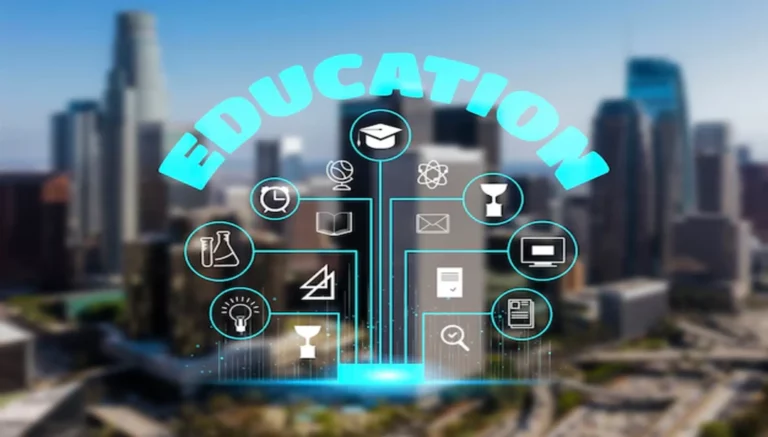
In today’s fast-paced and connected world, technology has changed the way we live, work, and, yes, even learn. It’s like we’ve entered a new era of education where traditional classrooms are being transformed into interactive, dynamic, and unique learning spaces. The good thing is that it’s pretty amazing. There’s a whole array of solutions that are reshaping classrooms and transforming education as we know it. So, let’s dive into the top EdTech tools and platforms for 2023!
Adaptive Education Platforms
Adaptive learning platforms have gained immense popularity due to their ability to provide individual learning experiences for individual students. These platforms leverage artificial intelligence (AI) and machine learning algorithms to assess students’ knowledge levels and tailor educational content accordingly. Adaptive learning platforms adjust to the individual needs and learning styles of students, optimizing their learning outcomes and promoting self-paced learning. Below are some prominent adaptive learning platforms.
- Knewton: Knewton is an adaptive learning platform that analyzes student data and provides individual recommendations and content based on individual strengths and weaknesses. It offers adaptive courses in subjects like math, science, and English.
- DreamBox Learning: DreamBox Learning is a great math learning platform designed for K-8 students. It provides complete lessons and feedback based on student’s specific learning needs and tracks their progress in real-time.
- Smart Sparrow: Smart Sparrow is an example platform that allows educators to create interactive and adaptive courseware. It provides custom learning paths, simulations, and virtual labs to enhance student engagement and understanding.
Virtual Reality (VR) and Augmented Reality (AR) Tools
Virtual and augmented reality tools have changed the way students perceive and interact with information. These technologies create simulated environments that engage students in a highly interactive and realistic manner. Here are some noteworthy VR and AR tools for education in 2023.
- ClassVR: ClassVR provides a comprehensive virtual reality platform designed specifically for classrooms. It offers a range of educational content and immersive experiences across various subjects. Students can explore historical landmarks, dive into the depths of the ocean, or even dissect virtual organisms, all within the safety of their classroom.
- Merge EDU: Merge EDU offers a range of AR and VR tools for hands-on learning. Their Merge Cube, a palm-sized cube, serves as a marker for AR experiences. Students can hold the cube and interact with holographic objects and simulations, bringing abstract concepts to life. Merge also provides VR headsets and content that enables students to explore virtual environments and engage in interactive learning activities.
- zSpace: zSpace combines AR and VR technologies to create a unique interactive learning experience. Their all-in-one system includes a high-resolution display, a stylus, and tracked glasses. Students can manipulate virtual objects, dissect virtual organisms, and conduct experiments, fostering a deeper understanding of complex subjects like science, engineering, and anatomy.
- Nearpod VR: Nearpod VR allows educators to deliver interactive VR lessons to students’ devices. It provides a library of pre-created VR content across various subjects, allowing students to explore virtual environments and engage in immersive learning activities. Educators can also create their own VR lessons using Nearpod’s authoring tools.
Collaborative Education Platforms
Collaborative platforms focus on the way students collaborate and communicate with peers and educators. These platforms promote group projects, discussions, and knowledge sharing. Some popular collaborative learning platforms in 2023 include:
- Google Workspace for Education: Google Workspace for Education (formerly G Suite for Education) provides a suite of collaboration tools such as Google Docs, Sheets, and Slides. It allows students to work together in real-time, edit documents simultaneously, and provide feedback to one another.
- Microsoft Teams: Microsoft Teams is a collaboration platform that integrates chat, video conferencing, file sharing, and task management. It enables students to communicate, collaborate on projects, and access shared resources in a single interface.
- Slack: Slack is a communication and collaboration platform widely used in educational settings. It offers channels for different subjects or projects, allowing students and educators to share information, and ask questions.
Artificial Intelligence (AI) Assistants
Artificial Intelligence (AI) assistants have made significant strides in education. These AI-powered tools use natural language processing and machine learning algorithms to understand and respond to students’ queries, provide explanations, and offer recommendations. Here are some noteworthy AI assistants in education.
- AskAway: AskAway is an AI assistant designed to provide instant answers and explanations to students’ questions. It uses advanced natural language processing to understand and respond to queries across a wide range of topics. AskAway also offers recommendations based on the individual for further learning resources based on individual student needs.
- Thinkster Math: Thinkster Math combines AI and human tutoring to provide math instruction. The AI component assesses students’ strengths and weaknesses, adapts the curriculum to their individual needs, and offers step-by-step explanations. Human tutors provide additional support and guidance as needed.
- Socratic by Google: Socratic is an AI-powered app developed by Google. It assists students by providing explanations and step-by-step solutions to a wide range of subjects. Students can take a photo of a question, and the app uses AI to provide relevant explanations and resources.
Online Learning Management Systems (LMS)
Online learning management systems have become essential tools for educational institutions, enabling the creation, delivery, and management of online courses and resources. These platforms facilitate online assessments, content sharing, and communication between students and educators. Notable online learning management systems include:
- Canvas: Canvas is a widely used learning management system that provides a comprehensive set of tools for online course delivery. It offers features like course materials management, grading, discussion boards, and assignment submission.
- Moodle: Moodle is an open-source learning management system that allows educators to create customizable online courses. It provides various features, including assessments, collaboration tools, and multimedia integration.
- Blackboard: Blackboard is a popular learning management system used by many educational institutions. It offers a range of tools for online course creation, student engagement, and assessment management.
Education Game Platforms
Games platforms leverage game elements and mechanics to enhance student engagement and motivation. These platforms transform learning into an interactive and enjoyable experience. We’ve listed some notable gamification platforms in 2023.
- Kahoot!: Kahoot! is a game platform that allows educators to create and share interactive quizzes, discussions, and surveys. It engages students through competitive game-based learning, promoting a sense of achievement and excitement.
- Classcraft: Classcraft gamifies the classroom experience by turning it into a collaborative role-playing game. Students earn points, level up, and unlock rewards as they progress through the curriculum.
- Quizlet: Quizlet offers a range of gamified study tools, including flashcards, quizzes, and games. Students can review and reinforce their knowledge through interactive activities, making learning engaging and fun.
Mobile Learning Apps
Mobile learning apps have become essential tools in education, providing students with on-the-go access to educational resources. These apps offer interactive lessons, practice exercises, and study materials.
- Duolingo: Duolingo is a language-learning app that offers bite-sized lessons, gamified exercises, and learning paths. It allows students to learn languages at their own pace and practice through interactive activities.
- Khan Academy: Khan Academy provides a wide range of educational videos, practice exercises, and quizzes across various subjects. The app enables individual learning and allows students to track their progress.
- Quizlet: As mentioned earlier in the gamification section, Quizlet is a versatile learning app that offers flashcards, quizzes, and games to reinforce knowledge and improve retention.
Data Analytics and Learning Analytics Tools
Data analytics and learning analytics tools provide valuable insights into student performance, engagement, and behavior, enabling educators to give individual instruction and tailor interventions. Noteworthy data analytics and learning analytics tools include:
- Brightspace Analytics: Brightspace Analytics is a comprehensive analytics platform that collects and analyzes data from various learning management systems. It offers visualizations and reports on student progress, engagement, and achievement, empowering educators to make informed decisions.
- Tableau: Tableau is a data visualization tool that helps educators and institutions analyze and present data in interactive and meaningful ways. It allows for the creation of customizable dashboards and reports, enabling educators to identify trends and patterns in student performance.
- Edsby: Edsby is a learning analytics platform that integrates data from various sources, including assessment results, attendance records, and student behavior data. It provides insights into individual student progress, allowing educators to identify areas of improvement and provide targeted support.
Online Tutoring and Mentoring Platforms
Online tutoring and mentoring platforms have become invaluable resources for students seeking support beyond the classroom. These platforms connect students with qualified tutors and mentors who provide individualized assistance in various subjects. Some notable online tutoring and mentoring platforms are:
- Tutor.com: Tutor.com offers on-demand tutoring services in a wide range of subjects. Students can connect with tutors in real time, receive help with homework, and get support.
- Chegg: Chegg provides online tutoring, textbook rentals, and study resources for students. It offers 24/7 access to subject experts, study guides, and practice materials.
- Brainly: Brainly is a collaborative learning platform where students can ask questions and receive answers from a community of peers and experts.
Education Webinar Tools
Video conferencing and webinar tools have played a key role in facilitating remote and hybrid learning models. These tools enable educators to deliver live virtual lectures, engage students in discussions, and facilitate interactive sessions.
- Zoom: Zoom is a popular video conferencing platform that offers features like screen sharing, breakout rooms, and chat. It provides a seamless virtual classroom experience, allowing for real-time interaction and collaboration.
- Google Meet: Google Meet is a video conferencing tool that is part of the Google Workspace for Education suite. It offers secure video meetings with features like screen sharing, chat, and real-time captions. Google Meet integrates smoothly with other Google tools, making it convenient for educators and students who already use Google services.
- Microsoft Teams: Microsoft Teams, as mentioned earlier in the collaborative learning platforms section, offers video conferencing capabilities alongside chat, file sharing, and task management features. It provides a comprehensive communication and collaboration solution for education.
- Slack: While primarily known as a communication and collaboration platform, Slack also offers video conferencing capabilities. It allows for video calls, screen sharing, and file sharing, making it a versatile tool for virtual meetings and discussions among educators and students.
The integration of education technology tools and platforms in the educational landscape of 2023 has restructured traditional classrooms, making learning more interactive, engaging, and accessible. Adaptive learning platforms, virtual and augmented reality tools, collaborative learning platforms, AI assistants, online learning management systems, game platforms, mobile learning apps, data analytics, and learning analytics tools, online tutoring and mentoring platforms, and video conferencing and webinar tools have reshaped the educational landscape. These tools help educators to give personal instruction, enhance student engagement, and make data-driven decisions to improve learning outcomes. As technology continues to advance, educators must stay updated with the latest tools and platforms and leverage them to effectively teach. With the continued integration of education technology, the future of education holds a brighter future for enhanced learning experiences, increased accessibility, and improved student outcomes.


